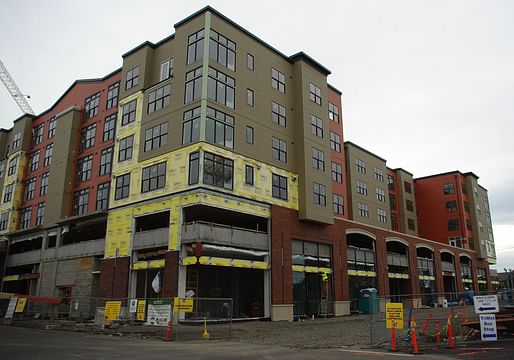

The new developments look startlingly alike, often in the form of boxy, mid-rise buildings with a ground-floor retail space, sans-serif fonts and vivid slabs of bright paneling. The bulky design is conspicuous, jutting out of downtown streets and overpowering its surroundings. Over time, it attracts a certain ecosystem — the craft breweries, the boutique coffee shops, the out-of-town young professionals.
It’s anytown architecture, and it’s hard to know where you are from one city to the next.
— The New York Times
The disappearance of America’s vernacular architecture and subsequent rise of what some call developer modernism is the product of necessity, reluctance towards artistry, and the monopolization of residential development across the country, according to the Times’ real estate reporter Anna Kodé.
The question of the kinds of structures (especially outside of large cities) they are replacing, if at all, is a potential counterargument in favor of their ubiquity. The larger question of whether drabness is a permanent condition of contemporary architecture, however, remains unanswered.

In a postscript with the Times’ Insider section, Kodé added: “I think one of the surprising things that came out of this story for me was finding out the number of people who defend these building types. I thought I would have to scrounge for those kinds of people. But a lot of people deeper in this world, like scholars, realize that this is happening because of how hard it is to get housing built, that developers and architects have kind of figured out this formula, all the problems they are going to run into, and this just happens to be the fastest way to get a building up, and the most cost-effective. And it’s obviously more nuanced than that. But I will say it did open my eyes to how this kind of housing is a positive force.”
7 Comments
the style was “driven by the planning regulations in any city.”
Naw paw, this style was driven by an architectural community not trained to design buildings that appeal to the public.
Indeed. The prevailing dogma among US designers to solve the problem of facades for large multifamily building with a kind of "pile it on" Victorian collage of shapes, colors, and different materials is evident everywhere you look.
nope. The article explains why buildings go the way they go. more or less. If it were the fault of architects that would be an amazing thing. But it isn't. I hate the entire premise of the article TBH, but it does outline the problem pretty neatly. Until the system deregulates at some place (doesn't have to be everywhere) we are going to continue as we are, under-performing and under-building, It's a bleak picture, with the main source of optimism coming from the fact that even governments are starting to worry that the status quo needs to change. Style of buildings has zero to do with it.
Your right that style has nothing to do with it but your wrong about our responsibility as architects. Beauty is largely a matter of composition, a skill widely studied before Modernists took over architecture schools. Architects have designed buildings under much more onerous conditions and done admirably. Good proportions are free, if you develop and eye for them.
I understand where you are coming from Thayer-D, however most of the proportions in these buildings are not up to the architect. Perhaps you have done a few and know how it goes, and maybe you were lucky to not have to deal with the particular reality of economics and regulations and construction explained in the article. But if so, you have been lucky. Funny enough while the USA sounds quite bad, it is much worse in the UK. It was one of the most difficult places to get anything built at all, and much of the decision-making on projects I was involved in was not even rational. In contrast, currently am working on a smallish housing project in Europe and while the planning authorities want to densify, and also want good architecture, we still need to satisfy a lot of external requirements that are not going to allow us to work from the position of just getting proportions right. We will try and I think we are doing a good job. BUT it is not something that can be reduced to such as simple mathematical game. It is perhaps more of a social one. And to be honest I rather think that is the correct place for architecture to begin. On the other hand when we work in Japan it is much easier because planning is deregulated in important ways. There is no housing crisis in Japan as a result (more or less because the country did what is proposed in this article in the 1970s). It can be said that it works because the cities are lively enough that bad architecture doesnt wreck things as much, maybe.... North America is harder because the domination of the car has created a poor setting as the basis for much of what follows. Even good proportions cant fix that. As for modernists not understanding or teaching proportion, I think you need to look to more recent architects for that. It would be awesome, however, to see all the badly proportioned Mies buildings lined up. There have to be a few out there. You know, that one time his hand slipped after a few too many drinks...
I've dealt with the kind of regulations and economic limitations mentioned here and no, they don't prevent good design any more than the limitations of certain materials or methods. It's not about luck or mathematics, it's about intention, practice, and most of all developing an eye. Knowing historical precedent is also useful, something schools discourage for reasons we all know. Never been to Japan, but I agree with your assessment from the photos I've seen. A visual feast when seen from afar, the average building not so much. I also agree about the car's dominance in US of A, but that mostly applies to the shluburbs which these kind of buildings are urbanizing, assuming good urban codes are in place. As for Mies, that's a matter of taste. My mind goes numb looking at his glass grids, golden proportioned or not. His small stuff not so bad. Those divine details only fly up close in my opinion.
Although I understand that everyone wants to accept certain elements as pre-ordained or " the most efficient..", I would suggest that this article (and most about housing), only go so far and then stop. That line being, "In 2021, five of the 25 largest developers were responsible for starting construction on nearly 47,000 units in the United States — about 40 percent of the output of the whole group". The issue with the american model (and sadly it is proliferating around the world) is the centralization of "development" within a very small sphere of developers with specific financing requirements required to achieve financing. Fundamentally I would like to posit that we don't have a simple equation of increased efficiency = bland non-specific results. I think it is instead that we have a condition where specific financial mechanisms + small pool of developers with specific ROI requirements = specific bland formula of development that relies heavily on development of housing as a 1-3 year investment and commercial underwriting that prioritizes specific high dollar/month retail rents to support the costs of development. So, in this consideration, the need for specific ROI for development projects requires a formulaic response that is fully disengaged from the locale, specific end consumer/user, or other "localizing" forces. This is essentially the corporatization of the landscape...and within this context architect become, at best, "stylists" of lifestyle marketing approaches to "target" a specific demographic upon which the developer may seek to capitalize on to support their ROI. One great example of this difference in approach is to see the proliferation of condominium and rental models versus alternative funded cooperative or other alternative funding models. It's quite fascinating to look at the history of housing development over the course of the 20th century. It connects many disparate narratives that undergird the current moment.
Block this user
Are you sure you want to block this user and hide all related comments throughout the site?
Archinect
This is your first comment on Archinect. Your comment will be visible once approved.